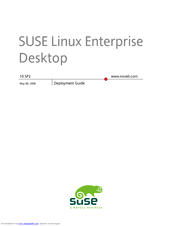NOVELL LINUX ENTERPRISE DESKTOP 10 SP2 - DEPLOYMENT GUIDE 08-05-2008 Manuals
Manuals and User Guides for NOVELL LINUX ENTERPRISE DESKTOP 10 SP2 - DEPLOYMENT GUIDE 08-05-2008. We have 1 NOVELL LINUX ENTERPRISE DESKTOP 10 SP2 - DEPLOYMENT GUIDE 08-05-2008 manual available for free PDF download: Deployment Manual
Advertisement
Advertisement
Related Products
- NOVELL IFOLDER 3.X - SECURITY ADMINISTRATOR GUIDE 08-15-2006
- NOVELL EDIRECTORY 8.8 - GUIDE 09-2006
- NOVELL INTELLISYNC MOBILE SUITE 7.0 - SECURE GATEWAY ADMINISTRATOR GUIDE 04-2006
- NOVELL LINUX ENTERPRISE SERVER 10 SP2 - STARTUP GUIDE 05-08-2008
- NOVELL OPEN ENTERPRISE SERVER 2 SP2 - LAB GUIDE 01-19-2010
- NOVELL PLATESPIN ORCHESTRATE 2.0.2 - HIGH AVAILABILITY CONFIGURATION GUIDE 06-17-2009
- NOVELL ZENWORKS LINUX MANAGEMENT 7.2 IR2 - ADMINISTRATION GUIDE 09-25-2008
- NOVELL ZENWORKS NETWORK ACCESS CONTROL 5.0 - INSTALLATION GUIDE 09-22-2008
- NOVELL SENTINEL 6.1 SP2 - INSTALLATION GUIDE 02-2010
- NOVELL ZENWORKS LINUX MANAGEMENT 7.3 IR2 - ADMINISTRATION GUIDE 02-12-2010
